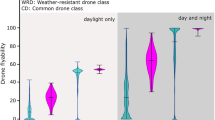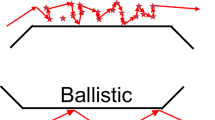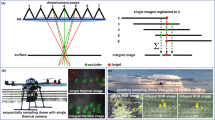Abstract
We are witnessing the advent of a new era of robots — drones — that can autonomously fly in natural and man-made environments. These robots, often associated with defence applications, could have a major impact on civilian tasks, including transportation, communication, agriculture, disaster mitigation and environment preservation. Autonomous flight in confined spaces presents great scientific and technical challenges owing to the energetic cost of staying airborne and to the perceptual intelligence required to negotiate complex environments. We identify scientific and technological advances that are expected to translate, within appropriate regulatory frameworks, into pervasive use of autonomous drones for civilian applications.
This is a preview of subscription content, access via your institution
Access options
Subscribe to this journal
Receive 51 print issues and online access
$199.00 per year
only $3.90 per issue
Buy this article
- Purchase on Springer Link
- Instant access to full article PDF
Prices may be subject to local taxes which are calculated during checkout



Similar content being viewed by others
References
Bouabdallah, S. Design and Control of Quadrotors with Applications to Autonomous Flying. PhD thesis, Ecole Polytechnique Federale de Lausanne (2007).
Ladson, C. L., Brooks, C. W. Jr, Hill, A. S. & Sproles, D. W. Computer Program to Obtain Ordinates for NACA Airfoils. Report No. 4741 (NASA, 1996).
Kumar, V. & Michael, N. Opportunities and challenges with autonomous micro aerial vehicles. Int. J. Robot. Res. 31, 1279–1291 (2012). This paper describes scaling laws for dynamics and control of quad rotors and related micro air vehicles.
Mellinger, D., Michael, N. & Kumar, V. Trajectory generation and control for precise aggressive maneuvers with quadrotors. Int. J. Robot. Res. 31, 664–674 (2012).
Brescianini, D., Hehn, M. & D'Andrea, R. Quadrocopter pole acrobatics. In Proc. International Conference on Intelligent Robots and Systems 3472–3479 (2013).
Shen, S., Mulgaonkar, Y., Michael, N. & Kumar, V. Vision-based state estimation and trajectory control towards aggressive flight with a quadrotor. In Proc. Robotics: Science and Systems http://www.roboticsproceedings.org/rss09/p32.html (2013).
Bry, A., Bachrach, A. & Roy, N. State estimation for aggressive flight in GPS-denied environments using onboard sensing. In Proc. IEEE International Conference on Robotics and Automation http://dx.doi.org/10.1109/ICRA.2012.6225295 (2012).
de Croon, G. C. H. E. et al. Design, aerodynamics and autonomy of the DelFly. Bioinspir. Biomim. 7, 025003 (2012).
Keennon, M., Klingebiel, K. & Won, H. Development of the Nano Hummingbird: a tailless flapping wing micro air vehicle. In Proc. AIAA Aerospace Sciences Meeting http://dx.doi.org/10.2514/6.2012-588 (2012).
Trimmer, W. S. N. Microrobots and micromechanical systems. Sens. Actuators 19, 267–287 (1989).
Wood, R. J. et al. Progress on 'pico' air vehicles. Int. J. Robot. Res. 31, 1292–1302 (2012).
Finio, B. M. & Wood, R. J. Distributed power and control actuation in the thoracic mechanics of a robotic insect. Bioinspir. Biomim. 5, 045006 (2010).
Ma, K., Chirarattananon, P., Fuller, S. & Wood, R. J. Controlled flight of a biologically inspired, insect-scale robot. Science 340, 603–607 (2013). This paper details the development of a flying robotic insect and the first controlled flight of this vehicle.
Wood, R. J., Steltz, E. & Fearing, R. S. Optimal energy density piezoelectric bending actuators. Sensors Actuators A: Physical 119, 476–488 (2005).
Phys.org. World's Lightest Micro-Flying Robot Built by Epson http://phys.org/news860.html (2004).
Kovac, M., Guignard, A., Nicoud, J.-D., Zufferey, J.-C. & Floreano, D. A 1.5g SMA-actuated microglider looking for the light. In Proc. International Conference on Robotics and Automation 367–372 (2007).
Shintake, J., Rosset, S., Schubert, B. E., Floreano, D. & Shea, H. A foldable antagonistic actuator. IEEE/ASME Trans. Mechatron. http://dx.doi.org/10.1109/TMECH.2014.2359337 (2014).
Dickinson, M. H., Lehmann, F. O. & Sane, S. P. Wing rotation and the aerodynamic basis of insect flight. Science 284, 1954–1960 (1999).
Wood, R. J., Nagpal, R. & Wei, G.-Y. Flight of the RoboBees. Sci. Am. 308 http://www.scientificamerican.com/article/robobee-project-building-flying-robots-insect-size/ (2013).
Sreetharan, P., Whitney, J. P., Strauss, M. & Wood, R. J. Monolithic fabrication of millimeter-scale machines. J. Micromech. Microeng. 22, 055027 (2012).
Daler, L., Klaptocz, A., Briod, A., Sitti, M. & Floreano, D. A perching mechanism for flying robots using a fibre-based adhesive. In Proc. International Conference on Robotics and Automation 4418–4423 (2013).
Moore, J. & Tedrake, R. Magnetic localization for perching UAVs on powerlines. In Proc. International Conference on Intelligent Robots and Systems 2700–2707 (2011).
Bachmann, R. J., Boria, F. J., Vaidyanathan, R. & Ifju, P. G. A biologically inspired micro-vehicle capable of aerial and terrestrial locomotion. Mechanism Mach. Theory 44, 513–526 (2009).
Peterson, K., Birkmeyer, P., Dudley, R. & Fearing, R. S. A wing-assisted running robot and implications for avian flight evolution. Bioinspir. Biomim. 6, 046008 (2011).
Gabrielli, G. & von Kármán, T. What price speed? Specific power required for propulsion of vehicles. Mech. Eng. 72, 775–781 (1950).
Daler, L., Mintchev, S., Stefanini, C. & Floreano, D. A bioinspired multi-modal flying and walking robot. Bioinspir. Biomim. 10, 016005 (2015).
Riskin, D. K. & Hermanson, J. W. Biomechanics: independent evolution of running in vampire bats. Nature 434, 292 (2005).
Itasse, M., Moschetta, J.-M., Ameho, Y. & Carr, R. Equilibrium transition study for a hybrid MAV. Inter. J. Micro Air Vehicles 3, 229–246 (2011).
Kalantari, A. & Spenko, M. Design and experimental validation of HyTAQ, a hybrid terrestrial and aerial quadrotor. In Proc. International Conference on Robotics and Automation 4445–4450 (2013).
Briod, A., Kornatowski, P. M., Zufferey, J.-C. & Floreano, D. A collision resilient flying robot. J. Field Robot. 31, 496–509 (2014).
Vidyasagar, A., Zufferey, J.-C., Floreano, D. & Kovac, M. Performance analysis of jump-gliding locomotion for miniature robotics. Bioinspir. Biomim. 10, 025006 (2015).
Woodward, M. A. & Sitti, M. MultiMo-Bat: a biologically inspired integrated jumping–gliding robot. Int. J. Robot. Res. 33, 1511–1529 (2014).
Desbiens, A. L., Pope, M. T., Christensen, D. L., Hawkes, E. W. & Cutkosky, M. R. Design principles for efficient, repeated jump gliding. Bioinspir. Biomim. 9, 025009 (2014).
Siddall, R. & Kovač, M. Launching the AquaMAV: bioinspired design for aerial–aquatic robotic platforms. Bioinspir. Biomim. 9, 031001 (2014).
Floreano, D., Zufferey, J.-C., Srinivasan, M. V. & Ellington, C. Flying Insects and Robots (Springer, 2009). This book provides an introduction to insect-inspired drones for biologists and engineers.
Land, M. F. & Nilsson, D.-E. Animal Eyes (Oxford Univ. Press, 2002).
Srinivasan, M. V. How insects infer range from visual motion. Rev. Oculomot. Res. 5, 139–156 (1993).
Gibson, J. J. The Perception of the Visual World (Houghton Mifflin, 1950).
Koenderink, J. J. Optic Flow. Vision Res. 26, 161–179 (1986).
Lehrer, M., Srinivasan, M. V., Zhang, S. W. & Horridge, G. A. Motion cues provide the bee's visual world with a third dimension. Nature 332, 356–357 (1988).
Franceschini, N., Riehle, A. & Le Nestour, A. in Facets of Vision (eds Stavenga, D. G. & Hardie, R. C.) 360–390 (Springer, 1989).
Krapp, H. G. & Hengstenberg, R. Estimation of self-motion by optic flow processing in single visual interneurons. Nature 384, 463–466 (1996).
Tammero, L. F. & Dickinson, M. H. The influence of visual landscape on the free flight behavior of the fruit fly Drosophila melanogaster. J. Exp. Biol. 205, 327–343 (2002).
Barron, A. & Srinivasan, M. V. Visual regulation of ground speed and headwind compensation in freely flying honey bees (Apis mellifera L.). J. Exp. Biol. 209, 978–984 (2006).
Srinivasan, M. V., Zhang, S. W., Altwein, M. & Tautz, J. Honeybee navigation: nature and calibration of the “odometer”. Science 287, 851–853 (2000).
Serres, J., Masson, G., Ruffier, F. & Franceschini, N. A bee in the corridor: centering and wall-following. Naturwissenschaften 95, 1181–1187 (2008).
Portelli, G., Ruffier, F. & Franceschini, N. Honeybees change their height to restore optic flow. J. Comp. Physiol. A Neuroethol. Sens. Neural Behav. Physiol. 196, 307–313 (2010).
Straw, A. D., Serin, L. & Dickinson, M. H. Visual control of altitude in flying Drosophila. Curr. Biol. 20, 1550–1556 (2010).
Egelhaaf, M. & Borst, A. A look into the cockpit of the fly: visual orientation, algorithms, and identified neurons. J. Neurosci. 13, 4563–4574 (1993).
Wagner, H. Flow-field variables trigger landing in flies. Nature 297, 147–148 (1982).
Baird, E., Boeddeker, N., Ibbotson, M. R. & Srinivasan, M. V. A universal strategy for visually guided landing. Proc. Natl Acad. Sci. USA 110, 18686–18691 (2013).
Taylor, G. K. & Krapp, H. G. Sensory systems and flight stability: what do insects measure and why? Adv. Insect Physiol. 34, 231–316 (2007).
Chahl, J. S., Srinivasan, M. V. & Zhang, S. W. Landing strategies in honeybees and applications to uninhabited airborne vehicles. Int. J. Robot. Res. 23, 101–110 (2004).
Garratt, M. A. & Chahl, J. S. Vision-based terrain following for an unmanned rotorcraft. J. Field Robot. 25, 284–301 (2008).
Griffiths, S. et al. Maximizing miniature aerial vehicles. IEEE Robot. Autom. Mag. 13, 34–43 (2006).
Zufferey, J.-C., Klaptocz, A., Beyeler, A., Nicoud, J.-D. & Floreano, D. A 10-gram vision-based flying robot. Adv. Robot. 21, 1671–1684 (2007).
Beyeler, A., Zufferey, J.-C. & Floreano, D. Vision-based control of near-obstacle flight. Auton. Robots 27, 201–219 (2009).
Chan, W. P., Prete, F. & Dickinson, M. H. Visual input to the efferent control system of a fly's “gyroscope”. Science 280, 289–292 (1998).
Collett, T. S. Some operating rules for the optomotor system of a hoverfly during voluntary flight. J. Comp. Physiol. A Neuroethol. Sens. Neural Behav. Physiol. 138, 271–282 (1980).
Baird, E., Srinivasan, M. V., Zhang, S. & Cowling, A. Visual control of flight speed in honeybees. J. Exp. Biol. 208, 3895–3905 (2005).
Ruffier, F. & Franceschini, N. Optic flow regulation: the key to aircraft automatic guidance. Robot. Auton. Syst. 50, 177–194 (2005).
Roubieu, F. L. et al. A biomimetic vision-based hovercraft accounts for bees' complex behaviour in various corridors. Bioinspir. Biomim. 9, 036003 (2014).
Conroy, J., Gremillion, G., Ranganathan, B. & Humbert, S. J. Implementation of wide-field integration of optic flow for autonomous quadrotor navigation. Auton. Robots 27, 189–198 (2009).
Briod, A., Zufferey, J.-C. & Floreano, D. Optic-flow based control of a 46 g quadrotor. In Proc. Workshop on Vision-based Closed-Loop Control and Navigation of Micro Helicopters in GPS-denied Environments http://rpg.ifi.uzh.ch/IROS13_TOC.html (2013).
Schuppe, H. & Hengstenberg, R. Optical properties of the ocelli of Calliphora erythrocephala and their role in the dorsal light response. J. Comp. Physiol. A Neuroethol. Sens. Neural Behav. Physiol. 173, 143–149 (1993).
Fuller, S. B., Karpelson, M., Censi, A., Ma, K. Y. & Wood, R. J. Controlling free flight of a robotic fly using an onboard vision sensor inspired by insect ocelli. J. R. Soc. Interface 11, 20140281 (2014).
Gremillion, G., Humbert, J. S. & Krapp, H. G. Bio-inspired modeling and implementation of the ocelli visual system of flying insects. Biol. Cybern. 108, 735–746 (2014).
Ruffier, F. & Franceschini, N. Optic flow regulation in unsteady environments: a tethered MAV achieves terrain following and targeted landing over a moving platform. J. Intell. Robot. Syst. http://dx.doi.org/10.1007/s10846-014-0062-5 (2014).
Ruffier, F., Viollet, S., Amic, S. & Franceschini, N. Bio-inspired optical flow circuits for the visual guidance of micro air vehicles. In Proc. International Symposium on Circuits and Systems 3, 846–849 (2003).
Duhamel, P.-E. J., Pérez-Arancibia, N. O., Barrows, G. & Wood, R. J. Biologically inspired optical-flow sensing for altitude control of flapping-wing microrobots. IEEE Trans. Mechatron. 18, 556–568 (2013).
Floreano, D. et al. Miniature curved artificial compound eyes. Proc. Natl Acad. Sci. USA 110, 9267–9272 (2013).
Song, Y. M. et al. Digital cameras with designs inspired by the arthropod eye. Nature 497, 95–99 (2013).
Zufferey, J. C. et al. Aerial collective systems. In Handbook of Collective Robotics (ed. Kernbach, S.) 609–660 (CRC, 2013). This chapter provides an introduction and survey of collective aerial vehicles.
Ballerini, M. et al. Interaction ruling animal collective behavior depends on topological rather than metric distance: evidence from a field study. Proc. Natl Acad. Sci. USA 105, 1232–1237 (2008).
Nagy, M., Akos, Z., Biro, D. & Vicsek, T. Hierarchical group dynamics in pigeon flocks. Nature 464, 890–893 (2010).
Reynolds, C. W. Flocks, herds, and schools: a distributed behavioral model. Comput. Graph. 21, 25–34 (1987).
Couzin, I. D., Krause, J., Franks, N. R. & Levin, S. A. Effective leadership and decision-making in animal groups on the move. Nature 433, 513–516 (2005).
Roberts, J., Stirling, T., Zufferey, J.-C. & Floreano, D. 3-D relative positioning sensor for indoor flying robots. Auton. Robots 33, 5–20 (2012).
Hauert, S. et al. Reynolds flocking in reality with fixed-wing robots: communication range vs. maximum turning rate. In Proc. International Conference on Robots and Systems 5015–5020 (2011).
Virágh, C. et al. Flocking algorithm for autonomous flying robots. Bioinspir. Biomim. 9, 025012 (2014).
Basiri, M., Schill, F. S., Floreano, D. & Lima, P. Audio-based localization for swarms of micro air vehicles. In Proc. International Conference on Robotics and Automation http://infoscience.epfl.ch/record/196274 (2014).
Scaramuzza, D. & Fraundorfer, F. Visual odometry: part I — the first 30 years and fundamentals. IEEE Robot. Autom. Mag. 18, 80–92 (2011).
Fraundorfer, F. & Scaramuzza, D. Visual odometry: part II — matching, robustness, and applications. IEEE Robot. Autom. Mag. 19, 78–90 (2012).
Davison, A. J. & Murray, D. W. Simultaneous localization and map-building using active vision. IEEE Trans. Pattern Anal. Mach. Intell. 24, 865–880 (2002).
Bachrach, A., He, R. & Roy, N. Autonomous flight in unknown indoor environments. Inter. J. Micro Air Vehicles 1, 217–228 (2009).
Scaramuzza, D. et al. Vision-controlled micro flying robots: from system design to autonomous navigation and mapping in GPS-denied environments. IEEE Robot. Autom. Mag. 21, 26–40 (2014). This paper details the development of a drone capable of outdoor simultaneous localization and mapping without GPS.
de Wagter, C., Tijmons, S., Remes, B. D. W. & de Croon, G. C. H. E. Autonomous flight of a 20-gram flapping wing MAV with a 4-gram onboard stereo vision system. In Proc. International Conference on Intelligent Robots and Systems 4982–4987 (2014).
Heng, L. et al. Autonomous visual mapping and exploration with a micro aerial vehicle. J. Field Robot. 31, 654–675 (2014).
Schauwecker, K. & Zell, A. On-board dual-stereo-vision for the navigation of an autonomous MAV. J. Intell. Robot. Syst. 74, 1–16 (2014).
Kendoul, F., Fantoni, I. & Nonami, K. Optic flow-based vision system for autonomous 3D localization and control of small aerial vehicles. Robot. Auton. Syst. 57, 591–602 (2009).
US Department of Transportation. Integration of Civil Unmanned Aircraft Systems (UAS) in the National Airspace System (NAS) Roadmap (US Department of Transportation Federal Aviation Authority, 2013).
UK Civil Aviation Authority. Unmanned Aircraft System Operations in UK Airspace — Guidance. Report CAP 722 (UK Civil Aviation Authority, 2012).
Ministère de l'Ecologie, du Developpement Durable, des Transports et du Logement. Relatif à l'utilisation de l'espace aérien par les aéronefs qui circulent sans personne à bord [in French]. Report No. Texte 9 sur 308, (Ministère de l'Ecologie, du Developpement Durable, des Transports et du Logement, 2012).
Swiss Federal Office of Civil Aviation. Drones and aircraft models http://www.bazl.admin.ch/dienstleistungen/02658/index.html?lang=en (Swiss Federal Office of Civil Aviation, 2014).
European RPAS Steering Group. Roadmap for the Integration of Civil Remotely-Piloted Aircraft Systems into the European Aviation System http://ec.europa.eu/enterprise/sectors/aerospace/uas/ (European RPAS Steering Group, 2013).
European Commission. A New Era for Aviation: Opening the Aviation Market to the Civil Use of Remotely Piloted Aircraft Systems in a Safe and Sustainable Manner. Report COM (2014) 207 (European Commission, 2014).
Haddon, D. R. & Whittaker, C. J. Aircraft airworthiness certification standards for civil UAVs. Aeronaut. J. 107, 79–86 (2003).
International Organization for Standardization. Robots and robotic devices — vocabulary ISO 8373:2012 (International Organization for Standardization, 2012).
Acknowledgements
D.F. and R.J.W. thank the Wyss Institute for Biologically Inspired Engineering at Harvard University, where this Review was written. D.F. also thanks the Swiss National Science Foundation through the National Centre of Competence in Research Robotics.
Author information
Authors and Affiliations
Corresponding author
Ethics declarations
Competing interests
The authors declare no competing financial interests.
Additional information
Reprints and permissions information is available at www.nature.com/reprints.
Rights and permissions
About this article
Cite this article
Floreano, D., Wood, R. Science, technology and the future of small autonomous drones. Nature 521, 460–466 (2015). https://doi.org/10.1038/nature14542
Received:
Accepted:
Published:
Issue Date:
DOI: https://doi.org/10.1038/nature14542
This article is cited by
-
Heat-assisted detection and ranging
Nature (2023)
-
Light-driven dandelion-inspired microfliers
Nature Communications (2023)
-
Energy efficient perching and takeoff of a miniature rotorcraft
Communications Engineering (2023)
-
Metamorphic aerial robot capable of mid-air shape morphing for rapid perching
Scientific Reports (2023)
-
Kinematic and Dynamic Analysis of a Compliant Mechanism to Generate Different Flapping-Wing Paths Based on Vibration Characteristics
Journal of Vibration Engineering & Technologies (2023)
Comments
By submitting a comment you agree to abide by our Terms and Community Guidelines. If you find something abusive or that does not comply with our terms or guidelines please flag it as inappropriate.



